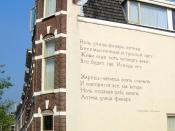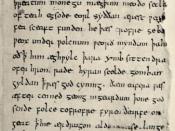'Afterwards,' by Thomas Hardy, is a poem that questions the way that people will look upon the narrator after his death. It centre's around the idea of 'noticing things,' showing the narrators precision and the ambivalence of his neighbours. Hardy gets this across by the techniques that he uses, and the detailed descriptions which show the full extent of what the narrator has noticed. The poem shows the complexity of nature, and describes the cycle of life.
The first stanza begins by personifying the 'Present,' which is very appropriate as the poem is concerned by the aliveness of the surroundings that it is describing. The reference to the back gate suggests closure, and is a very precise way of describing the end of the narrator's life. This sense of closure is also demonstrated in the structure of the poem, which is self-contained in its alternate rhyming quatrains. It has a rhyming pattern of abab, which means that the poem is soft and pleasing to hear, reflects the quietness of nature and goes along with the idea of the man being gentle and 'tremulous'.
It is also pleasing to the eye as each stanza loosely mirrors the previous one. However the number of syllables varies in each line, which means the poem is not constrained by its structure. This is fitting to the content of the poem as there are references to birds, and flying which has the connotations of freedom.
An example of this is, 'And the May month flaps its glad green leaves like wings.' This animal imagery is totally un-restrictive, as well as painting a very bright and vibrant picture of the season that he is describing. The alliteration, combined with each line only having one syllable helps to achieve the bouncing, jolly effect. The line also...



Afterwards
Nicely done. Thomas hardy is one of my favorite poets so thanks alot. Also, a small biblography to site yours sources would be nice to. Good job.
0 out of 0 people found this comment useful.